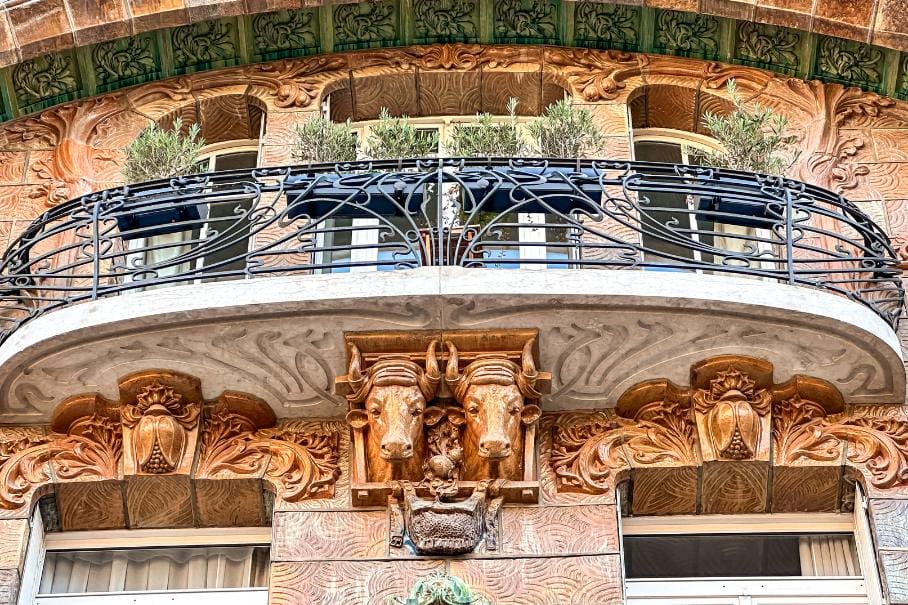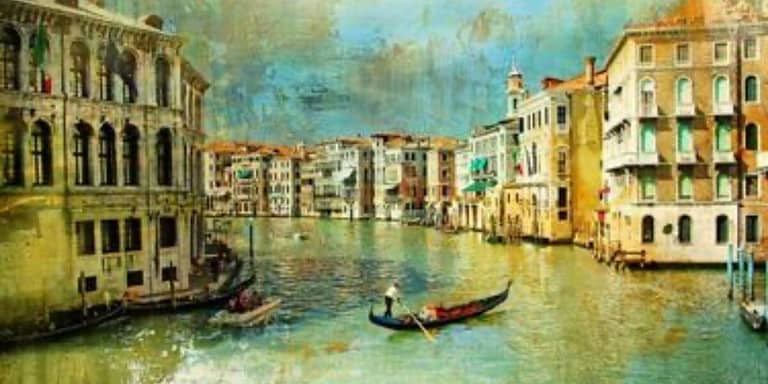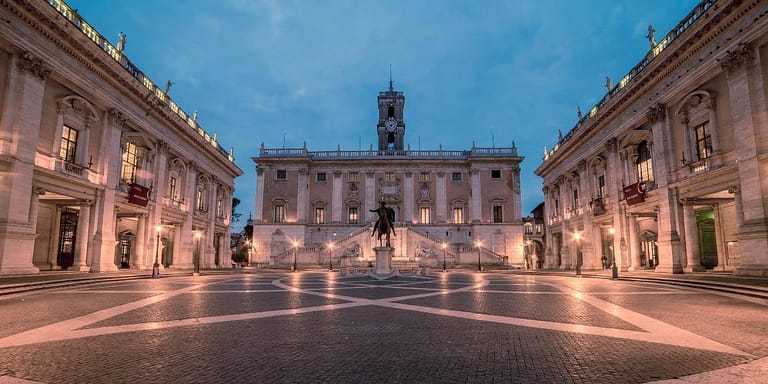Guide to Art Nouveau in Paris, an indulgence for the senses
Paris, the city of lights and love, is also the city of art. It’s a city rich in history, cultural significance, and, my favourite, architectural marvels. While the architecture in Paris has its own importance and influence, the Parisian culture and its deep connection with the Art Nouveau movement draws me here every single time.
Art Nouveau in Paris might not be as noticeable to the untrained eye. However, once you know where to look, you’ll find outstanding examples of this movement throughout the city. For me, exploring Parisian Art Nouveau is an artistic indulgence. Let’s dive in.
Affiliate Disclosure – This post contains affiliate links. If you make a purchase through these links, I may earn a commission. This doesn’t affect your purchases or any fees you may pay for the product or service. Read more in my DISCLAIMER.
What is Art Nouveau
Art Nouveau, which translates to ‘New Art,’ emerged at the end of the 19th century and became popular in Europe and the United States until World War I broke out. It was characterized by its use of organic forms and motifs inspired by nature, as well as a focus on craftsmanship and attention to detail.
The Art Nouveau movement was a reaction against the increased industrialization, technological innovation and mass production happening at that time. The movement celebrated the beauty of natural forms with intricate designs inspired by plants, flowers, and other natural elements. Here are some characteristics that define it:
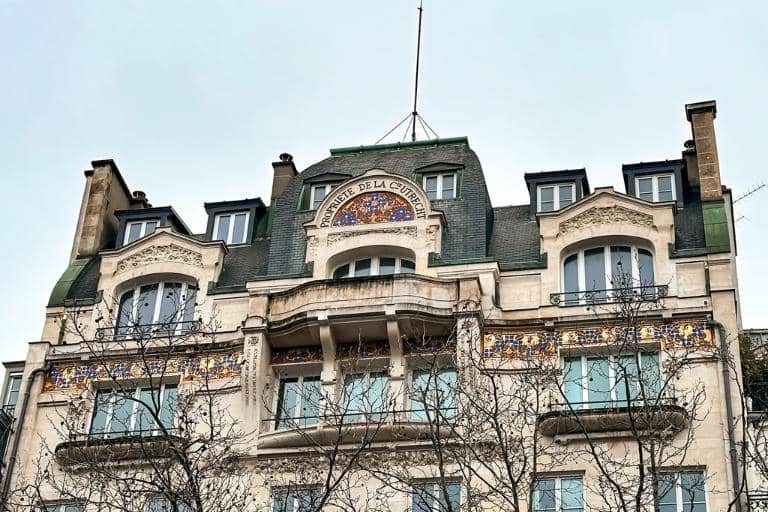
- Curved lines: Art Nouveau favoured flowing, curving lines instead of straight ones. These can be seen in architectural details like doorways, windows and balconies.
- Nature-inspired motifs: One of the hallmarks of Art Nouveau is its use of natural motifs, such as flowers, plants and animals. These can be found in sculptures, stained glass windows and decorative elements.
- Use of new materials: Art Nouveau artists were also known for incorporating new materials like iron, glass, and ceramic tiles into their designs.
- Attention to detail: Art Nouveau was all about attention to detail, which is evident in the intricate designs and patterns in its architecture and decorative objects.
Why is there so much Art Nouveau in Paris?
Paris was a prominent center for the Art Nouveau movement in the late 19th and early 20th centuries. The city’s booming economy and artistic culture provided a perfect breeding ground for this new style of art and design.
Paris was also a hub for artists and designers from Europe, who were drawn to the city’s vibrant artistic scene. These artists and designers brought their own interpretations of Art Nouveau, resulting in diverse styles within the movement.
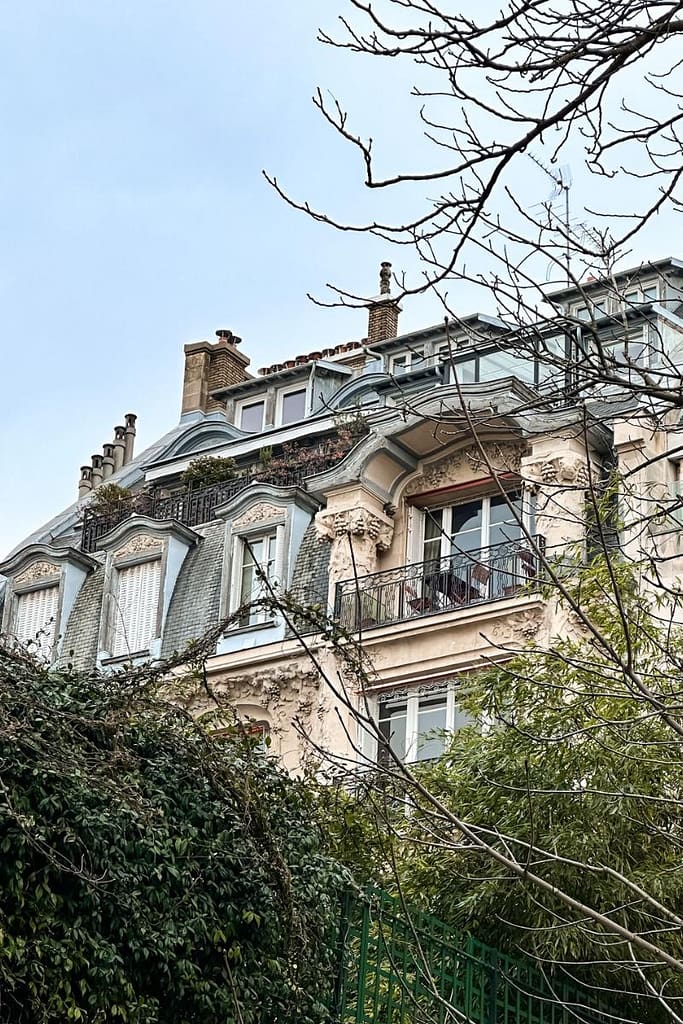
Let’s not forget that Paris was undergoing a massive transformation in the late 19th century, with the construction of grand boulevards and iconic buildings such as the Eiffel Tower. This created an opportunity for Art Nouveau to be incorporated into the city’s architecture and interior design, making it a prominent feature of Parisian life.
Best places to see art nouveau in Paris
While you can find Parisian Art Nouveau all over the city, the 7th and 16th arrondissements offer a concentration of significant sites. If you only have a little time to explore, these two districts are a good starting point. As I mentioned, once you know what to look for, you can spot Art Nouveau buildings in Paris as you explore. Think of it as a fun architectural treasure hunt for your visit.
Art Nouveau in Paris 7th arrondissement
Start your exploration with a walk down Avenue Rapp. It is a picturesque boulevard that encapsulates the essence of Art Nouveau in Paris. I found it less crowded, which gave me a chance to admire the buildings around me without stepping on anyone’s toes.
29 Avenue Rapp, Lavirotte Building
This striking building, designed by Jules Lavirotte, is a jewel of Art Nouveau architecture. Constructed between 1899 and 1901 and designed by the architect Jules Lavirotte, the buildings’s entryway and external facade embody Art Nouveau’s organic inspirations. The facade is intricately decorated with decorative tiles, sculptures, and ironwork that defy the architectural norms of the time.
Awarded the Paris façade competition prize in 1903, it is noted for blending functionality with exquisite aesthetic principles—a tangible homage to the era’s innovative spirit and the artisan’s virtuosity. You’ll likely want to spend a lot of time taking pictures of it like I did.
Square Rapp
Just a few steps from the Lavirotte Building, Square Rapp offers a more intimate glimpse into the heart of Parisian Art Nouveau. This secluded square is home to a collection of buildings that bear the iconic hallmarks of the style, from fluid, naturalistic lines to the incorporation of floral and fauna motifs. Nobody was around when I stopped by, and I also got a great view of the Eiffel Tower from this spot.
Noteworthy is the apartment at number 3, also designed by Lavirotte. This private mansion showcases a facade richly adorned with elegant wrought ironwork and expressive stone carvings that exemplify Art Nouveau’s harmonious integration with nature.
112 rue Saint-Dominique, Maison Bergeron bakery
Take a break with a stop at this marvellous bakery. Here, you can find an assortment of pastries, bread and drinks, and a beautiful Art Nouveau-decorated interior. There is a lot of intricate detailing on the walls and the ceiling, with large mirrors and iconic-style images. It gives quite a punch to your senses when you walk in, which makes it a great find.
The bakery is relatively small, with only a few tables outside. Still, it has large windows which allow you to admire the inside without holding up the line. I recommend the raspberry macaron – it’s to die for. You can enjoy it at the table outside or take it to go.
33 rue du Champ de Mars, Cours Alfred-de-Musset College
Here, you’ll find yet another architectural marvel deeply ingrained with Art Nouveau’s charisma. It was designed by the architect Octave Raquin around 1900. The design won him an award at the Facade Competition in 1902.

The façade showcases floral motifs, flowing lines, and decorative ironwork, embodying the movement’s emphasis on integrating art into everyday life. Thanks to its decor, the building has been dubbed the House of Lilies (La Maison des Arums).
12 rue Sedillot, Leonardo da Vinci school
While most of the street is lined with stunning architecture, the building at number 12 catches the eye. Dating to 1899, it has quite a history. It was once the Monttessuy Hotel, and then after WWII, it became the Leonardo da Vinci Italian High School.

Also designed by Lavirotte, its stone facade is enlivened by fantastical and fluid motifs commonly present in Art Nouveau. It blends mythical and natural elements that add playfulness to the design.
90 and 151 rue de Grenelle
A stroll along Rue de Grenelle is truly a feast for the eyes. Here, you’ll find many gorgeous facades. I came across two that spoke to me and are worth checking out on your Art Nouveau treasure hunt.
I could only find limited information on the 90 rue de Grenelle building. It was designed by Henri Deglane in 1906 and he received a prize for it at the Facades Competition of the city of Paris. The building is on the corner and has a brick facade decorated with wrought iron balconies and various heads of men, women and beasts.
The second building, also designed by Jules Lavirotte in 1898, is another eloquent expression of Art Nouveau’s elegance. The white stone facade is less elaborate than some of his later works, but you can see the Art Nouveau motifs in the door, wood and ironwork. Close up, you can even spot salamander handles.
Lamps of the Pont Alexandre III
The Pont Alexandre III, known for its extravagant ornamentation, boasts stunning Art Nouveau lamps. Designed by engineer Jean Résal and architect Amédée Alby, they feature ornate scrolling and floral motifs, each a unique piece of art.

Art Nouveau in Paris 16th arrondissement
Moving to the 6th arrondissement, Rue du Cherche-Midi is another delightful street that offers a glimpse into the Art Nouveau heritage of Paris. While less densely populated with Art Nouveau buildings than some other areas, you can still discover gems that showcase the movement’s influence.
14 rue Jean de La Fontaine, Castel Béranger
Located in the 16th arrondissement, Castel Béranger is a masterpiece designed by the influential architect Hector Guimard. This residential building, completed in 1898, is a prime example of Art Nouveau architecture. The façade is adorned with sinuous ironwork, floral motifs, and asymmetrical designs, showcasing Guimard’s innovative and organic approach to construction.

39 rue Scheffer
The building at 39 rue Scheffer is a fine example of Art Nouveau architecture designed by Ernest Herscher in 1911. The façade features intricate ironwork, floral motifs, and asymmetrical designs, characteristic of the Art Nouveau movement. It adds a touch of elegance to the streetscape and highlights the movement’s influence on Parisian residential architecture.

Art Nouveau in Paris Other arrondissements
With over 400 Art Nouveau buildings across the city, there is a lot to cover. Here are my picks for where you can find Art Nouveau in Paris across different arrondissements that speak to the widespread influence of Art Nouveau throughout Paris.
La Samaritaine, 1st Arrondissement
Situated on the right bank of the Seine, La Samaritaine is a historic department store with a rich Art Nouveau connection. While the original building was constructed in the early 20th century, it underwent renovations that blended Art Nouveau elements with Art Deco influences. The stunning glass roof and intricate ironwork on the exterior are reminiscent of the era’s design aesthetics.

Kimpton Hotel, 2nd Arrondissement
The Kimpton Hotel, with its Art Nouveau-inspired interiors, offers a luxurious and immersive experience. Located in the heart of Paris, this boutique hotel seamlessly integrates period details, such as stained glass and ornate metalwork, creating a harmonious blend of past and present.
Grand Palais, 8th Arrondissement
Built for the Exposition Universelle in 1900, the Grand Palais is a testament to Art Nouveau’s influence on monumental architecture. The main entrance features intricate ironwork and decorative details, reflecting the movement’s commitment to harmonizing art and architecture on a grand scale.
27bis quai Anatole France, ADIT headquarters, 8th Arrondissement
Situated in the 8th arrondissement, the headquarters of ADIT (Agence pour la Diffusion de l’Information Technologique) is a modern interpretation of Art Nouveau. The building incorporates organic forms and flowing lines, paying homage to the movement while infusing a contemporary touch.

Hotel Elysees Ceramic, 8th Arrondissement
Nestled near the Champs-Élysées, the Hotel Elysees Ceramic is another Art Nouveau gem. The façade features delicate wrought iron balconies, floral patterns, and ornate details, capturing the essence of the movement’s commitment to beauty and craftsmanship.

Galeries Lafayette, 9th Arrondissement
This iconic Parisian department store on Boulevard Haussmann in the 9th arrondissement boasts a stunning Art Nouveau dome. The glass and steel structure, designed by architect Ferdinand Chanut, serves as the store’s centrepiece. The dome, with its delicate motifs and natural light, creates a captivating atmosphere for shoppers and visitors alike.
14 rue d’Abbeville, 9th Arrondissement
In the 10th arrondissement, 14 rue d’Abbeville is another hidden gem showcasing Art Nouveau details. The façade of this building might reveal organic forms, decorative ironwork, and possibly stained glass, contributing to the neighbourhood’s unique character and reflecting the widespread influence of Art Nouveau across various districts of Paris.

Metro Entrances
The entrances to many of Paris’ metro stations were designed in the Art Nouveau style by Hector Guimard. These iconic entrances can be found scattered throughout the city, and they are a must-see for any Art Nouveau lover.

Recommended tours of Art Nouveau in Paris
Art Nouveau architecture in Paris, a must-see
With its romantic ambiance and artistic flair, Paris is a treasure trove for Art Nouveau aficionados. Here, you can immerse yourself in the flowing lines, organic motifs, and timeless elegance that define this movement. Let the streets of Paris be your canvas, and may your journey through Art Nouveau be as enchanting as the movement itself. À votre santé et à l’art!
As Victor Hugo once said, “To study in Paris is to be born in Paris!” And to be born in Paris, even if only for a short while, is to appreciate the beauty of Art Nouveau. And if you want more of Paris, there are many great movies that can transform you there.

